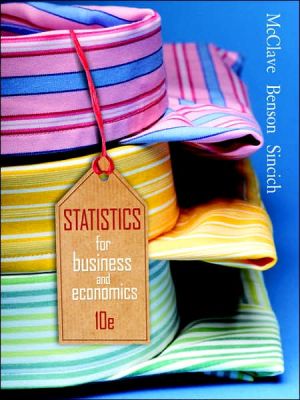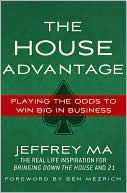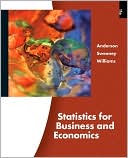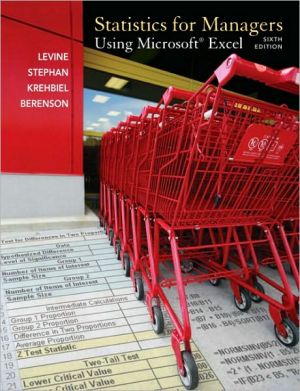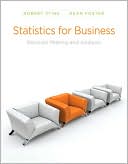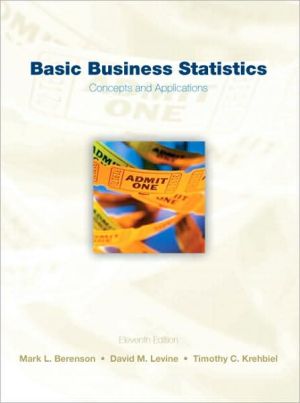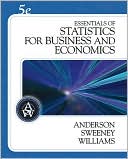Statistics for Business and Economics
Statistics for Business and Economics, 7/e, is the tool students need to help them become informed business decision makers in the twenty-first century. Important statistical ideas and techniques are presented within the context of real-life business situations. The reader is challenged to think critically about problems and to employ one of the many technological tools available - including EXCEL, SPSS, SAS, or Minitab - to reach an informed, well-presented conclusion. Exciting new...
Search in google:
Classic, yet contemporary. Theoretical, yet applied. Statistics for Business and Economics, Eleventh Edition, gives you the best of both worlds. Using a rich array of applications from a variety of industries, McClave/Sincich/Benson clearly demonstrates how to use statistics effectively in a business environment.The book focuses on developing statistical thinking so the reader can better assess the credibility and value of inferences made from data. As consumers and future producers of statistical inferences, readers are introduced to a wide variety of data collection and analysis techniques to help them evaluate data and make informed business decisions. As with previous editions, this revision offers an abundance of applications with many new and updated exercises that draw on real business situations and recent economic events. The authors assume a background of basic algebra. Booknews A new edition of an advanced undergraduate level text intended for students with a non-calculus background. Presents statistical theory and principles in the context of real business situations to encourage practical problem-solving. Also covers some of the technological tools available, including EXCEL, SPSS, SAS, or Minitab. MacIntosh or Windows data disk includes learning objectives, thinking challenges, concept presentation slides, and worked examples. Annotation c. by Book News, Inc., Portland, Or.
PREFACE: \ Preface\ This eighth edition of Statistics for Business and Economics is an introductory business text emphasizing inference, with extensive coverage of data collection and analysis as needed to evaluate the reported results of statistical studies and to make good decisions. As in earlier editions, the text stresses the development of statistical thinking, the assessment of credibility and value of the inferences made from data, both by those who consume and those who produce them. It assumes a mathematical background of basic algebra.\ A briefer version of the book, A First Course in Business Statistics, is available for single semester courses that include minimal coverage of regression analysis, analysis of variance, and categorical data analysis.\ NEW IN THE EIGHTH EDITION\ Major Content Changes\ Chapter 2 includes two new optional sections: methods for detecting outliers (Section 2.8) and graphing bivariate relationships (Section 2.9).\ Chapter 5 now covers descriptive methods for assessing whether a data set is approximately normally distributed.\ Chapter 11 is a new multiple regression chapter. The material on multiple regression models and model building (Chapters 11 and 12 in previous editions) is reorganized into a single, streamlined chapter, with initial emphasis on the first-order model. More complex models (e.g., interaction, quadratic, and dummy variable models) are presented in increasing order of difficulty. Coverage of residual analysis (Section 11.13) is expanded to include treatment of heteroscedastic errors.\ Exploring Data withStatistical Computer Software and the Graphing Calculator—Throughout the text, computer printouts from four popular Windows-based statistical software packages (SAS, SPSS, MINITAB, STATISTIX) are displayed and used to make decisions about the data. New to this edition, we have included instruction boxes and output for the TI-83 graphing calculator.\ Statistics in Action—One or two features per chapter examine current real-life, high-profile issues. Data from the study is presented for analysis. Questions prompt the students to form their own conclusions and to think through the statistical issues involved.\ Real-World Business Cases—Six extensive business problem-solving cases, with real data and assignments. Each case serves as a good capstone and review of the material that has preceded it.\ Real-Data Exercises—Almost all the exercises in the text employ the use of current real data taken from a wide variety of publications (e.g., newspapers, magazines, and journals).\ Quick Review—Each chapter ends with a list of key terms and formulas, with reference to the page number where they first appear.\ Language Lab—Following the Quick Review is a pronunciation guide for Greek letters and other special terms. Usage notes are also provided.\ TRADITIONAL STRENGTHS\ We have maintained the features of Statistics for Business and Economics that we believe make it unique among business statistics texts. These features, which assist the student in achieving an overview of statistics and an understanding of its relevance in the business world and in everyday life, are as follows:\ The Use of Examples as a Teaching Device\ Almost all new ideas are introduced and illustrated by real data-based applications and examples. We believe that students better understand definitions, generalizations, and abstractions after seeing an application.\ Many Exercises—Labeled by Type\ The text includes more than 1,400 exercises illustrated by applications in almost all areas of research. Because many students have trouble learning the mechanics of statistical techniques when problems are couched in terms of realistic applications, all exercise sections are divided into two parts:\ \ Learning the Mechanics. Designed as straightforward applications of new concepts, these exercises allow students to test their ability to comprehend a concept or a definition.\ \ \ \ Applying the Concepts. Based on applications taken from a wide variety of journals, newspapers, and other sources, these exercises develop the student's skills to comprehend real-world problems and describe situations to which the techniques may be applied.\ \ A Choice in Level of Coverage of Probability (Chapter 3)\ One of the most troublesome aspects of an introductory statistics course is the study of probability. Probability poses a challenge for instructors because they must decide on the level of presentation, and students find it a difficult subject to comprehend. We believe that one cause for these problems is the mixture of probability and counting rules that occurs in most introductory texts. We have included the counting rules in a separate and optional section at the end of the chapter on probability. In addition, all exercises that require the use of counting rules are marked with an asterisk (*). Thus, the instructor can control the level of coverage of probability.\ Extensive Coverage of Multiple Regression Analysis\ and Model Building (Chapter 11)\ This topic represents one of the most useful statistical tools for the solution of applied problems. Although an entire text could be devoted to regression modeling, we believe we have presented coverage that is understandable, usable, and much more comprehensive than the presentations in other introductory statistics texts.\ We devote three chapters to discussing the major types of inferences that can be derived from a regression analysis, showing how these results appear in computer printouts and, most important, selecting multiple regression models to be used in an analysis. Thus, the instructor has the choice of a one-chapter coverage of simple regression, a two-chapter treatment of simple and multiple regression, or a complete three-chapter coverage of simple regression, multiple regression, and model building. This extensive coverage of such useful statistical tools will provide added evidence to the student of the relevance of statistics to the solution of applied problems.\ Footnotes\ Although the text is designed for students with a non-calculus background, footnotes explain the role of calculus in various derivations. Footnotes are also used to inform the student about some of the theory underlying certain results. The footnotes allow additional flexibility in the mathematical and theoretical level at which the material is presented.\ SUPPLEMENTS FOR THE INSTRUCTOR\ The supplements for the eighth edition have been completely revised to reflect the revisions of the text. To ensure adherence to the approaches presented in the main text, each element in the package has been accuracy checked for clarity, and freedom from computational, typographical, and statistical errors.\ Annotated Instructor's Edition (AIE) (ISBN 0-13-027985-4)\ Marginal notes placed next to discussions of essential teaching concepts include:\ \ Teaching Tips—suggest alternative presentations or point out common student errors\ Exercises—reference specific section and chapter exercises that reinforce the concept\ A disk icon identifies data sets and file names of material found on the data disks\ Short Answers—section and chapter exercise answers are provided next to the selected exercises\ \ Instructor's Notes by Mark Dummeldinger (ISBN 0-13-027410-0)\ This printed resource contains suggestions for using the questions at the end of the Statistics in Action boxes as the basis for class discussion on statistical ethics and other current issues, solutions to the Real-World Cases, a complete short answer book with letter of permission to duplicate for student use, and many of the exercises and solutions that were removed from previous editions of this text.\ Instructor's Solutions Manual by Nancy S. Boudreau\ (ISBN 0-13-027421-6)\ Solutions to all of the even-numbered exercises are given in this manual. Careful attention has been paid to ensure that all methods of solution and notation are consistent with those used in the core text. Solutions to the odd-numbered exercises are found in the Student's Solutions Manual.\ Test Bank by Mark Dummeldinger (ISBN 0-13-027419-4)\ Entirely rewritten, the Test Bank now includes more than 1,000 problems that correlate to problems presented in the text.\ Test Gen EQ\ \ Menu-driven random test system\ Networkable for administering tests and capturing grades online\ Edit and add your own questions—or use the new "Function Plotter" to create a nearly unlimited number of tests and drill worksheets\ \ PowerPoint Presentation Disk by Mark Dummeldinger\ (ISBN 0-13027365-1)\ This versatile Windows-based tool may be used by professors in a number of different ways:\ \ Slide show in an electronic classroom\ Printed and used as transparency masters\ Printed copies may be distributed to students as a convenient note-taking device\ \ Included on the software disk are learning objectives, thinking challenges, concept presentation slides, and examples with worked-out solutions. The PowerPoint Presentation Disk may be downloaded from the FTP site found at the McClave Web site.\ Data Disk—available free with every text purchased from Prentice Hall\ The data sets for all exercises and cases are available on a 3 1/2" diskette in ASCII format in the back of the book. When a given data set is referenced, a disk symbol and the file name will appear in the text near the exercise.\ McClave Internet Site (...
PrefaceCh. 1Statistics, Data, and Statistical Thinking1Ch. 2Methods for Describing Sets of Data25Ch. 3Probability111Ch. 4Discrete Random Variables161Ch. 5Continuous Random Variables201Ch. 6Sampling Distributions239Ch. 7Inferences Based on a Single Sample: Estimation with Confidence Intervals269Ch. 8Inferences Based on a Single Sample: Tests of Hypothesis317Ch. 9Inferences Based on Two Samples: Confidence Intervals and Tests of Hypotheses367Ch. 10Simple Linear Regression429Ch. 11Multiple Regression499Ch. 12Model Building577Ch. 13Methods for Quality Improvement661Ch. 14Time Series: Descriptive Analyses, Models, and Forecasting733Ch. 15Design of Experiments and Analysis of Variance799Ch. 16Nonparametric Statistics867Ch. 17The Chi-Square Test and the Analysis of Contingency Tables913Ch. 18Decision Analysis947App. ABasic Counting Rules999App. B: Tables1003App. CCalculation Formulas for Analysis of Variance1036Answers to Selected Exercises1038References1051Index1057
\ BooknewsFor business students ready for total immersion in multiple regression analysis, model building, analysis of variance, and categorical data analysis, this iteration offers such highlights as exploring data with statistical computer software and the TI-83 graphing calculator, "statistics in action" issues (e.g. ethics in computer technology and use), and reality-based exercises. Appends basic counting rules, statistical tables, analysis of variance formulas, and answers to selected exercises. Supplementary materials are available. Those who find this weighty text daunting may be relieved to know that a streamlined version, , for single semester courses is available. McClave is at the U. of Florida. No dates are furnished for previous editions. Annotation c. Book News, Inc., Portland, OR (booknews.com)\ \ \ \ \ BooknewsA new edition of an advanced undergraduate level text intended for students with a non-calculus background. Presents statistical theory and principles in the context of real business situations to encourage practical problem-solving. Also covers some of the technological tools available, including EXCEL, SPSS, SAS, or Minitab. MacIntosh or Windows data disk includes learning objectives, thinking challenges, concept presentation slides, and worked examples. Annotation c. by Book News, Inc., Portland, Or.\ \
